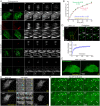Self-construction of actin networks through phase separation-induced abLIM1 condensates
- PMID: 35858327
- PMCID: PMC9304016
- DOI: 10.1073/pnas.2122420119
Self-construction of actin networks through phase separation-induced abLIM1 condensates
Abstract
The abLIM1 is a nonerythroid actin-binding protein critical for stable plasma membrane-cortex interactions under mechanical tension. Its depletion by RNA interference results in sparse, poorly interconnected cortical actin networks and severe blebbing of migrating cells. Its isoforms, abLIM-L, abLIM-M, and abLIM-S, contain, respectively four, three, and no LIM domains, followed by a C terminus entirely homologous to erythroid cortex protein dematin. How abLIM1 functions, however, remains unclear. Here we show that abLIM1 is a liquid-liquid phase separation (LLPS)-dependent self-organizer of actin networks. Phase-separated condensates of abLIM-S-mimicking ΔLIM or the major isoform abLIM-M nucleated, flew along, and cross-linked together actin filaments (F-actin) to produce unique aster-like radial arrays and interconnected webs of F-actin bundles. Interestingly, ΔLIM condensates facilitated actin nucleation and network formation even in the absence of Mg2+. Our results suggest that abLIM1 functions as an LLPS-dependent actin nucleator and cross-linker and provide insights into how LLPS-induced condensates could self-construct intracellular architectures of high connectivity and plasticity.
Keywords: F-actin networks; actin polymerization; cell cortex; liquid–liquid phase separation; self-construction.
Conflict of interest statement
The authors declare no competing interest.
Figures






Similar articles
-
The Role of Liquid-Liquid Phase Separation in Actin Polymerization.Int J Mol Sci. 2023 Feb 7;24(4):3281. doi: 10.3390/ijms24043281. Int J Mol Sci. 2023. PMID: 36834689 Free PMC article. Review.
-
abLIM1 constructs non-erythroid cortical actin networks to prevent mechanical tension-induced blebbing.Cell Discov. 2018 Jul 24;4:42. doi: 10.1038/s41421-018-0040-3. eCollection 2018. Cell Discov. 2018. PMID: 30062045 Free PMC article.
-
Molecular characterization of abLIM, a novel actin-binding and double zinc finger protein.J Cell Biol. 1997 Aug 11;138(3):575-88. doi: 10.1083/jcb.138.3.575. J Cell Biol. 1997. PMID: 9245787 Free PMC article.
-
Actin binding LIM 1 (abLIM1) negatively controls osteoclastogenesis by regulating cell migration and fusion.J Cell Physiol. 2018 Jan;234(1):486-499. doi: 10.1002/jcp.26605. Epub 2018 Jun 15. J Cell Physiol. 2018. PMID: 29904924
-
Mechanostress resistance involving formin homology proteins: G- and F-actin homeostasis-driven filament nucleation and helical polymerization-mediated actin polymer stabilization.Biochem Biophys Res Commun. 2018 Nov 25;506(2):323-329. doi: 10.1016/j.bbrc.2018.09.189. Epub 2018 Oct 9. Biochem Biophys Res Commun. 2018. PMID: 30309655 Review.
Cited by
-
A Hierarchical Mechanotransduction System: From Macro to Micro.Adv Sci (Weinh). 2024 Mar;11(11):e2302327. doi: 10.1002/advs.202302327. Epub 2023 Dec 25. Adv Sci (Weinh). 2024. PMID: 38145330 Free PMC article. Review.
-
The Role of Liquid-Liquid Phase Separation in Actin Polymerization.Int J Mol Sci. 2023 Feb 7;24(4):3281. doi: 10.3390/ijms24043281. Int J Mol Sci. 2023. PMID: 36834689 Free PMC article. Review.
-
A transcriptome-based risk model in sepsis enables prognostic prediction and drug repositioning.iScience. 2024 Oct 28;27(12):111277. doi: 10.1016/j.isci.2024.111277. eCollection 2024 Dec 20. iScience. 2024. PMID: 39628572 Free PMC article.
-
Phase separation-mediated biomolecular condensates and their relationship to tumor.Cell Commun Signal. 2024 Feb 21;22(1):143. doi: 10.1186/s12964-024-01518-9. Cell Commun Signal. 2024. PMID: 38383403 Free PMC article. Review.
-
Interplay of self-organization of microtubule asters and crosslinking protein condensates.PNAS Nexus. 2023 Jul 13;2(7):pgad231. doi: 10.1093/pnasnexus/pgad231. eCollection 2023 Jul. PNAS Nexus. 2023. PMID: 37497046 Free PMC article.
References
-
- Bennett V., Baines A. J., Spectrin and ankyrin-based pathways: Metazoan inventions for integrating cells into tissues. Physiol. Rev. 81, 1353–1392 (2001). - PubMed
-
- Baines A. J., The spectrin-ankyrin-4.1-adducin membrane skeleton: Adapting eukaryotic cells to the demands of animal life. Protoplasma 244, 99–131 (2010). - PubMed
-
- Köster D. V., Mayor S., Cortical actin and the plasma membrane: Inextricably intertwined. Curr. Opin. Cell Biol. 38, 81–89 (2016). - PubMed
Publication types
MeSH terms
Substances
LinkOut - more resources
Full Text Sources
Miscellaneous

